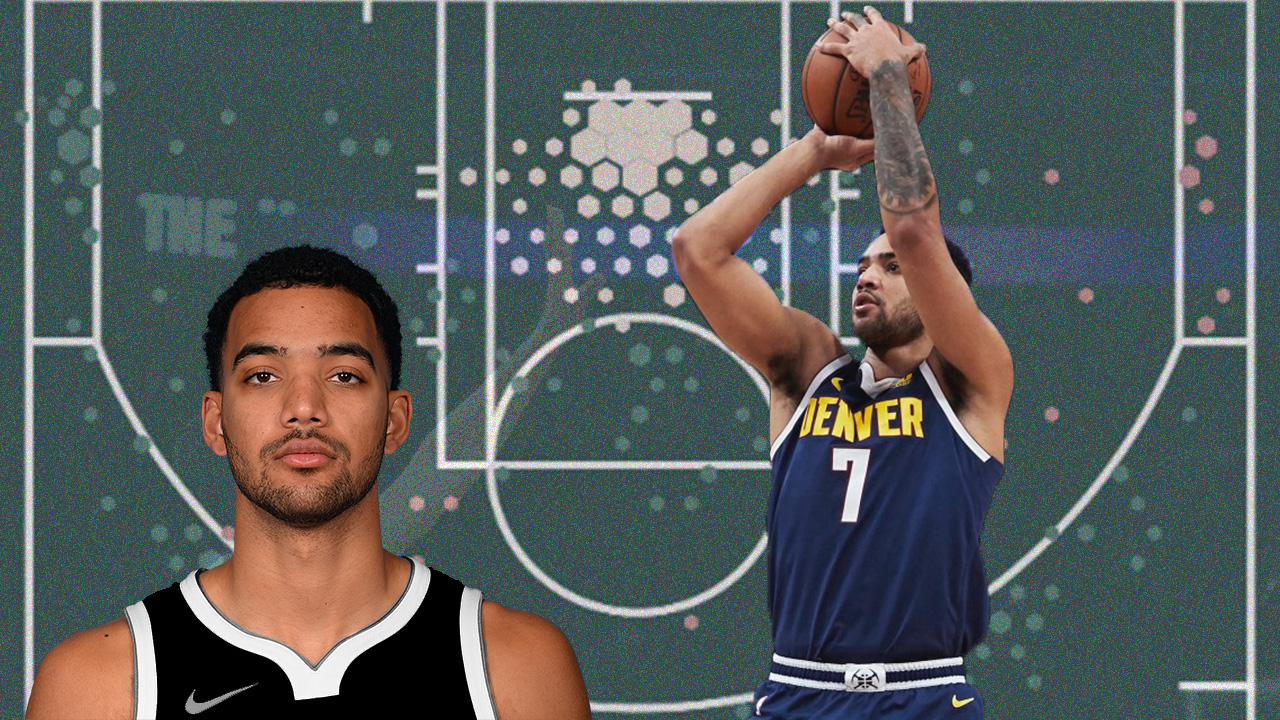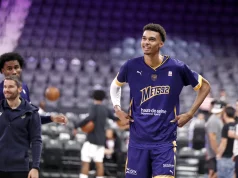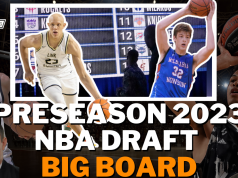Coming into the season, Trey Lyles felt like the Spurs’ third choice for the power forward spot. The Spurs wanted the defense, shooting, experience, and toughness of Marcus Morris, who then reneged on his agreement to sign with the Spurs. By then, the team had already traded away fan-favorite Davis Bertans, and his red-hot three-point shooting has been sorely missed in San Antonio.
The Spurs signed Lyles after these mishaps. At the time, the primary consolation was his affordable contract (non-guaranteed next year). The team would be able to move on from him if and when a better option became available.
However, Lyles clearly impressed Popovich as he started the season opener and all but 10 games since then. Since then, Lyles has taken substantial steps and looks like a player that could figure in the Spurs’ future plans, even as they add talent and give their recent draft picks bigger roles.
He has refined the skills that earned him a starting spot and added versatile off-the-dribble and passing dimensions to his game. This growth reflects well on the Spurs’ continued ability to develop young players as well as Lyles’ work ethic and basketball IQ. As the Spurs rebuild the roster in the coming years, Lyles’ development means that they have an effective and versatile weapon to slot into their team-building plans.
Lyles’ Core Skills – Rebounding and 3-Point Shooting
Lyles’ reputation built in Utah and Denver was as a jack of all trades, master of none. From the power forward position, he could shoot, handle the ball, and defend multiple positions- but wasn’t particularly good at any of them. He was a 33% three-point shooter through the first four years of his career and only 4/29 in his one college season.
Lyles had an above-average usage rate with Denver and Utah’s bench units, but below-average efficiency. He only had one season with an effective field goal percentage over 50%, in 2017-2018 when hot three-point shooting (38%) led to much better efficiency numbers. With his place in the team uncertain, Denver renounced his rights last summer in favor of trading for forward Jeremi Grant. This left Lyles an unrestricted free agent who signed with the Spurs after the Marcus Morris drama left them short a power forward.
At the start of his Spurs career, the coaching staff had the versatile but unpolished Lyles focus on two things: rebounding and 3-point shooting. This year 48.2% of his field-goal attempts are 3-pointers, up from 40% in Denver. Lyles is sinking them at a 38.7% clip. While 3-point percentages are always prone to large fluctuations, sinking a career-high 73.3% of his free throws this year point is a positive sign for his shooting stroke.
Less glamorous, but of vital importance to the Spurs’ floundering defense, is Lyles’ consistency on the boards. Rebounding was a point of early-season emphasis from Coach Popovich, and Lyles has delivered. His 10.2 rebounds per 36 minutes is up from his previous career-high (’17-’18 season) of 9.0 per 36 minutes. The Spurs as a whole grab 77.3% of defensive rebounds with Lyles on the floor and 73.7% without him – this despite numerous recent games where he has played center against larger, traditional big men.
It’s no secret that Pop values smart, high-effort basketball, and in this inconsistent season he has leaned heavily on Trey’s solid, fundamental play.
Unlocking Lyles’ Defensive Potential
On defense, Lyles has some impressive and unique skills and some notable weaknesses. With the various lineups and schemes that the Spurs have tried this year, both have been on display.
While exciting on offense as a small-ball center, Lyles can get overpowered on the defensive end. He is in the bottom 25% of the league’s players in defending post-ups, and bottom third among forwards with a 63.8% allowed on shots at the rim. Even bigger 4s can take advantage of him, as Domantas Sabonis did in their recent loss to Indiana.
Trey Lyles’ defensive potential lies in his ability to cover both guards and forwards on the perimeter. His switch defense against guards has taken a slight step forward this year.
| 2017-2018 | 2018-2019 | 2019-2020 | |
| True Shooting Percentage Allowed Defending Guards | 54.1%% | 57.2% | 51.9% |
Given that San Antonio likes to switch perimeter screens and handoffs, he will have ample opportunity to prove that this kind of defensive playmaking against guards is sustainable and not a mere blip.
When locked in, Lyles can deliver similar results even against premier wing players like LeBron James:
This ability to defend forwards and guards, and Lyles’ quick thinking on defense, allows the Spurs to employ switch-everything schemes that neutralize opponent screen and handoff actions.
The Spurs have good defensive guards, but lacking a stopper against top wings has hurt them all season. If Lyles can develop into that player while also being versatile enough to cover other opponent ball handlers over the course of a possession, the Spurs’ defensive ceiling becomes dramatically higher.
From Play Finisher to Playmaker
For much of the year, Lyles’ offensive role was strictly as a spot-up shooter. In the past two years, over 25% of his field goals were unassisted. This year, that number is only 14.2%, evidence that Lyles is generally relying on his teammates to set him up.
However, his focus on that shooting stroke has opened up other aspects of Lyles’ game. When defenders close out hard, he shows the ability to drive against them and finish well at the rim:
Lyles has also integrated well into the Spurs’ offense, which has been good this year despite the team’s overall struggles. While Lyles still averages one assist per game, as he did in Denver, he maintains this despite a more limited ballhandling role in San Antonio. 14.6% of possessions that Lyles uses (shoots, assists, or commits a turnover) have been an assist, up from 12.4% last year. Popovich has increasingly turned back away from isolation-heavy to the free-flowing improvisational style of their last championship run. This year, 5.5% of Spurs possessions involve isolation plays (17th in the league) compared to 6.8% last year (12th).
Note Lyles’ quick decision to drive and his understanding that when Larry Nance helps, Murray will be open behind him.
Other players, including many guards, might be too fixated on getting to the rim to read and react to the help defense. Watch Lyles, and you will see that his decisions are always quick but not rushed, perfect for the “0.5-second” rule of past Spurs teams.
With his 3-and-D skills and his ability to provide playmaking and movement, Lyles fits well into the Spurs offense. His defensive versatility allows the Spurs to utilize multiple lineup and scheme options.
Trey Lyles is by no means the answer to the Spurs’ problems this season. If the Spurs can sign a top power forward, they should certainly do so. However, Lyles’ development gives the team the security of knowing that they have a promising two-way player who matches the skill set and age of the Spurs’ young core.
Should Lyles be in the team’s long-term plans? Follow me @fern_garcia and let me know what you think!






